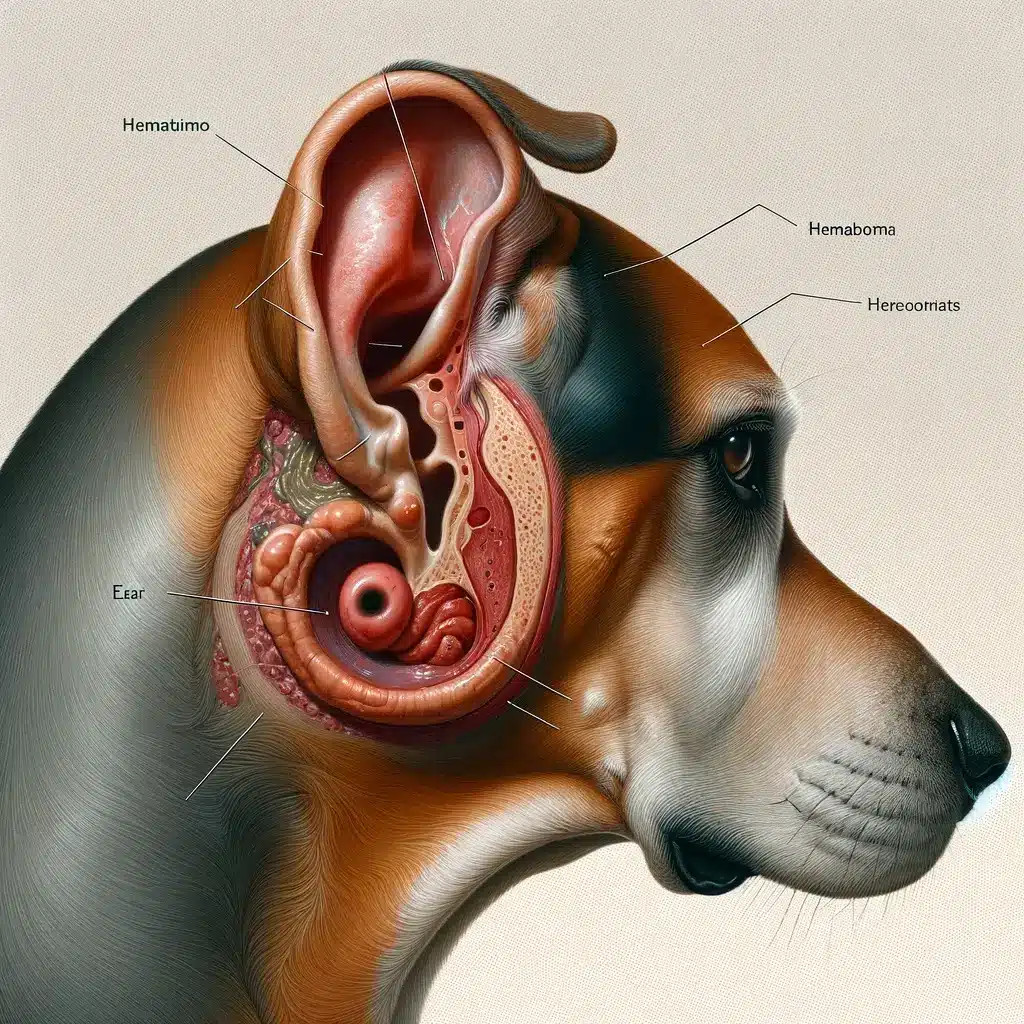When my French Bulldog, Milo, wouldn’t stop scratching his ear last summer, his ear flap swelled up like a little pillow. Worried, I called my vet, Dr. Carter, who diagnosed an aural hematoma—a painful blood clot caused by his scratching. This guide blends my journey with Milo and Dr. Carter’s expertise to help US dog owners understand ear hematomas, their treatment, and prevention, whether you’re in a busy New York apartment or a quiet Texas ranch. Use our Dog Breed Selector Tool to check if your breed, like French Bulldogs or Cane Corsos, is prone to ear issues.
What Is a Dog Ear Hematoma?
An aural hematoma is a blood clot under the skin of a dog’s ear flap (pinna), caused by a ruptured blood vessel. Blood pools between the cartilage and skin, forming a soft, swollen pocket. Dr. Carter explained that Milo’s hematoma came from scratching due to a yeast infection. It’s common in breeds with floppy ears, like French Bulldogs, Cocker Spaniels, or your Cane Corso, Titan, but can affect any dog. The swelling can be a small lump or cause the entire ear flap to droop [1].
Causes of Dog Ear Hematoma
Aural hematomas result from trauma to the ear flap, often due to:
- Ear Infections: Bacterial or yeast infections cause itching, leading to scratching or head shaking. Milo’s yeast infection was triggered by humid summer weather [2].
- Ear Mites: These parasites cause intense scratching, especially in puppies or rescue dogs [3].
- Allergies: Food allergens (e.g., wheat, corn) or environmental triggers (e.g., pollen) spark itching. Milo’s wheat sensitivity was a factor [2].
- Injuries: Dog fights or ear bites can break blood vessels. Titan’s rough play could put him at risk [1].
- Foreign Objects: Grass seeds or debris in the ear canal prompt head shaking, worsening infections [1].
Dr. Carter says vigorous head shaking or scratching ruptures blood vessels under the ear flap’s thin skin, causing blood to collect.
Symptoms of Dog Ear Hematoma
Milo’s hematoma became obvious once I knew the signs. Dr. Carter highlighted these symptoms:
- Swollen ear flap, looking like a small, soft balloon on part or all of the pinna.
- Warm, moist area due to blood buildup.
- Redness or discharge, often with an odor from infections.
- Excessive scratching, like Milo’s nonstop ear scratching.
- Head tilting or pain, with dogs flinching when the ear is touched.
- Droopy ear, especially in breeds like French Bulldogs if swelling is severe.
These symptoms don’t always confirm a hematoma, so a vet visit is essential [1].
Home Treatment for Dog Ear Hematoma
Dr. Carter strongly advises against treating hematomas at home, as draining or ignoring them risks recurrence and complications. You can manage underlying causes to support recovery:
- Address Allergies: If food allergies (e.g., wheat, ~6.8g sugar/100g per your beetroot query [2]) cause itching, switch to hypoallergenic kibble like Purina Pro Plan Sensitive Skin or Blue Buffalo Basics. Milo’s wheat-free diet helped [2].
- Ear Cleaning: Use vet-recommended solutions like Zymox Ear Cleanser weekly to prevent infections. Avoid unproven remedies like apple cider vinegar or green tea, which can irritate [1].
- Supplements: Omega-3 fats (e.g., Nordic Naturals fish oil) reduce inflammation. Dr. Carter cautions against unverified treatments like bee pollen or Chinese herbs [2].
- Monitor Infections: For diabetic dogs (per your query), avoid sugary treats like beetroot (~6.8g sugar/100g); use green beans (~0.5g sugar/100g) after 8 PM to prevent digestive upset [2].
Home remedies only help if the hematoma is mild and the root cause is addressed, says Dr. Carter.
How to Drain a Dog Ear Hematoma at Home?
Draining a hematoma at home is not recommended, as it risks infection, incomplete removal, and recurrence. Dr. Carter drained Milo’s small hematoma with a syringe under sterile conditions, followed by medication. Home drainage lacks precision and can worsen scarring. Always see a vet for safe drainage or surgical options [1].
How to Prevent Aural Hematoma?
Preventing hematomas means tackling root causes, says Dr. Carter:
- Treat Ear Infections Early: Use vet-prescribed antibiotics or antifungals for infections. Milo’s yeast infection was caught early [2].
- Control Ear Mites: Monthly parasite prevention (e.g., Revolution, Bravecto) stops mites. Check rescue dogs from ASPCA shelters [3].
- Clean Ears Regularly: Use Zymox for breeds like French Bulldogs or Cane Corsos to prevent debris buildup [1].
- Avoid Injuries: Supervise play to prevent ear bites, especially for active dogs like Titan [1].
- Manage Allergies: Hypoallergenic diets and antihistamines reduce itching [2].
Regular ear cleaning and vet checkups kept Milo’s ears healthy.
What Should You Do After Treatment?
Post-treatment care is crucial, per Dr. Carter:
- Monitor Drainage Sites: After Milo’s drainage, I cleaned the site with vet-recommended antiseptic soap to prevent infection.
- Suture Removal: Sutures, if used, are removed after 7–14 days. Milo’s small hematoma didn’t need stitches [1].
- Follow-Up Exams: Check the ear canal for infections. Milo’s follow-up confirmed no recurrence.
- Prevent Scratching: Use a cone to stop scratching, which could reopen the hematoma [1].
Dr. Carter emphasizes treating infections to prevent new hematomas.
Is Professional Surgery Needed for Your Dog’s Ear Hematoma?
For small hematomas like Milo’s, syringe drainage may work, but larger or clotted hematomas require surgery. Surgery involves cutting the ear flap, removing clots, and suturing to prevent refilling. Dr. Carter says surgery is often best for breeds like French Bulldogs, as non-surgical drainage can lead to recurrence, especially with clots [1].
What Happens If You Leave a Dog’s Ear Hematoma Untreated?
Untreated hematomas cause serious issues, warns Dr. Carter:
- Pain and Discomfort: The swollen ear’s weight causes pain, as Milo showed by flinching.
- Infection Complications: Swelling blocks treatment of underlying infections, worsening discharge [2].
- Ear Deformity: Scarring can create a “cauliflower ear,” common in floppy-eared breeds like Cocker Spaniels [1].
- Recurrence Risk: Untreated hematomas may shrink but often recur, requiring more extensive treatment [1].
Milo’s early treatment prevented these problems.
Breed Comparison Table
This table compares ear hematoma risks across breeds prone to ear issues, based on veterinary data [1][2].
| Breed | Ear Hematoma Risk (1–10) | Ear Cleaning Frequency (Times/Month) |
|---|---|---|
| French Bulldog | 8 | 4 |
| Cane Corso | 7 | 3 |
| Cocker Spaniel | 9 | 4 |
| Labrador Retriever | 6 | 2 |
Note: Risk (1–10) reflects ear type and infection susceptibility; cleaning frequency shows preventative care needs.
FAQs
- Can I treat a hematoma at home? No, draining at home risks infection; consult a vet [1].
- Which breeds are prone to hematomas? Floppy-eared breeds like French Bulldogs, Cane Corsos, and Cocker Spaniels [2].
- Safe treats for dogs with ear issues? Green beans (~0.5g sugar/100g), not beetroot (~6.8g sugar/100g) for diabetic dogs [2].
Key Takeaways
- Treatment Needs: Vet drainage or surgery, regular ear cleaning, hypoallergenic diet.
- Prevention Tips: Use Zymox, treat infections early, manage allergies.
- Vet Advice: Consult a vet like Dr. Carter for safe, effective treatment.
- Breed Risks: Floppy-eared breeds like French Bulldogs and Cane Corsos are prone to hematomas.
Final Thoughts
Milo’s ear hematoma was a stressful moment, but Dr. Carter’s quick intervention kept him comfortable and wagging. Treating ear hematomas promptly prevents pain, deformities, and recurrence, especially for breeds like French Bulldogs or your Cane Corso, Titan. Use our Dog Breed Selector Tool to check your breed’s ear health risks, and shop Zymox or Purina Pro Plan at PetSmart or local pet stores. Whether you have a snuggly Frenchie like Milo or a protective giant like Titan, early vet care keeps your pup happy and healthy!
References:
- VCA Hospitals, “Aural Hematoma in Dogs”.
- Rover, “Dog Allergies and Diet”.
- ASPCA, “Ear Mites in Dogs”.



